Lichens of North America Information
(formerly www.lichen.com)
Lichens of North America Information |
Lichen Vocabulary
INTRODUCTION TO LICHEN MORPHOLOGY AND TERMINOLOGY
return to Lichen Biology and the Environment
Go to Lichens and Ecosystems (Nutrient cycling, soils, and environmental monitoring with lichens)
GROWTH FORMS
Lichens are arbitrarily classified into three to seven growth forms that do not reflect how the lichens are related to each other. Different species within a genus may have different growth forms.
CRUSTOSE
Crustose lichens form crusts that are so tightly attached to the rocks, trees, sidewalks, or soils they grow on that they can't be removed without damaging the substrate.
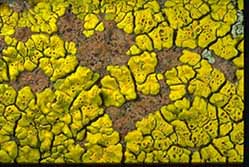 Cracked
crusts like this species of Acarospora (or
Pleopsidium) that are separated into segments (areoles) are called
areolate.
Cracked
crusts like this species of Acarospora (or
Pleopsidium) that are separated into segments (areoles) are called
areolate.
Crustose lichens that grow immersed in rocks with only their fruiting bodies above the surface are called endolithic, and those that grow immersed in plant tissues are called endophloidic or endophloidal. Loose, powdery lichen crusts without a layered structure are called leprose.
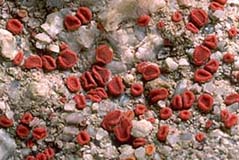 Caloplaca
luteominea subspecies bolanderi, an endolithic
crust.
Caloplaca
luteominea subspecies bolanderi, an endolithic
crust.
FOLIOSE
Foliose lichens are somewhat leaf-like, composed of lobes. They are relatively loosely attached to their substrates, usually by means of rhizines (see below). Their lobes have upper and lower sides and usually grow more-or-less parallel to the substrate. Umbilicate lichens are attached to their substrate only at a central point. (See Lasallia papulosa)
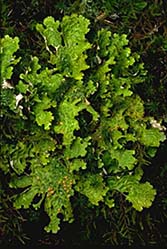 Lobaria
linita has large, leaf-like lobes.
Lobaria
linita has large, leaf-like lobes.
FRUTICOSE
Fruticose lichens are the most three-dimensional. They're ususally round in cross secetion (terete), and most are branched. They can be like little shrubs growing upward, or they can hang down in long strands.
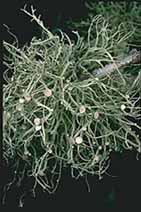 Ramalina
stenospora
Ramalina
stenospora 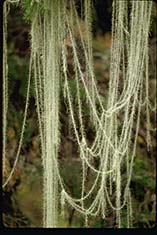 Usnea
longissima
Usnea
longissima
SQUAMULOSE
Squamulose lichens have scale-like lobes called squamules that are usually small and overlapping.
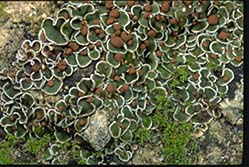 The
squamules of Psora pseudorusselli
are edged in white. Note the brown fruiting bodies.
The
squamules of Psora pseudorusselli
are edged in white. Note the brown fruiting bodies.
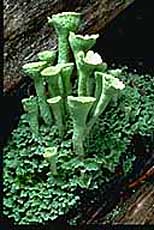 Cladonia
carneola. Lichens in the genus Cladonia have squamulose
bases and often have fruticose fruiting structures called podetia.
Cladonia
carneola. Lichens in the genus Cladonia have squamulose
bases and often have fruticose fruiting structures called podetia.
THALLUS The "plant body" of an individual lichen is called a thallus.
Nearly all lichens have an upper (or in the case of fructicose lichens an outer) cortex, which is a dense, protective skin of fungal tissue. Below that is a photosynthetic layer, which can be a colony of either green algae or cyanobacteria. (See Lichen Biology and the Environment .) Then there is a layer of loose threads (hyphae) of the lichen fungus, called the medulla or the medullary layer. Some foliose lichens have a lower cortex, and others just have an exposed medulla. Crustose lichens never have a lower cortex--their medullary layer attaches firmly to the substrate.
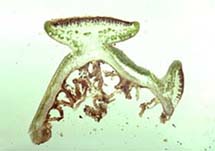 A section through a species
of Physcia. Note the green layer of algal cells and the branching brown
rhizines on the bottom. The middle part of the lichen, in white,
consists of fungal tissue, called the medulla. The top and right-hand
dish-shaped structures are apothecia (see Reproductive Structures,
below) and the brown layer on each of these is composed of asci,
the parts of an ascomycete that contain the fungal spores.
A section through a species
of Physcia. Note the green layer of algal cells and the branching brown
rhizines on the bottom. The middle part of the lichen, in white,
consists of fungal tissue, called the medulla. The top and right-hand
dish-shaped structures are apothecia (see Reproductive Structures,
below) and the brown layer on each of these is composed of asci,
the parts of an ascomycete that contain the fungal spores.
Some lichens that have cyanobacteria as the photosynthetic partner (photobiont) have a gelatinous texture, and some of these do not have a layered (or stratified) thallus--the symbiotic partners are just all mixed up together. Some kinds of stratified lichens have a lump of cyanobacteria, called a cephalodium contained in the lichen (or sometimes on its surface) in addition to the layer of algae--one organism made of of components from three separate kingdoms! For a picture of this type of lichen see the discussion of Lobaria near the beginning of Lichen Biology and the Environment. and also the photo of a section, Lobaria pulmonaria.
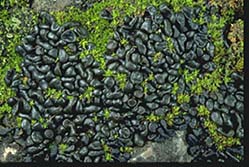 Collema
coccophorum, a lichen with a cyanobacterium as
the photobiont (the green part of the photo is a moss).
Collema
coccophorum, a lichen with a cyanobacterium as
the photobiont (the green part of the photo is a moss).
REPRODUCTIVE STRUCTURES
Nearly all lichen fungi (which are called mycobionts) are members of the order Ascomycotina and commonly known as Ascomycetes, though a few are members of Basidiomycotina and called Basidiomycetes. The two orders make different types of fruiting bodies, which are spore-producing structures. The most common kind of fruiting body in Ascomycete lichens is the apothecium (plural, apothecia) made by Ascomycetes, which is generally shaped like a disc, usually with a rim around the edge. Discs can become very contorted and appear as cracks in the surface of the thallus, called lyrellae (see portrait of Phaeographis inusta) or as nearly spherical blobs. (see portrait of Dibaeis baeomyces).
return to Lichen Biology and the Environment
Go to Lichens and Ecosystems (Nutrient cycling, soils, and environmental monitoring with lichens)
|